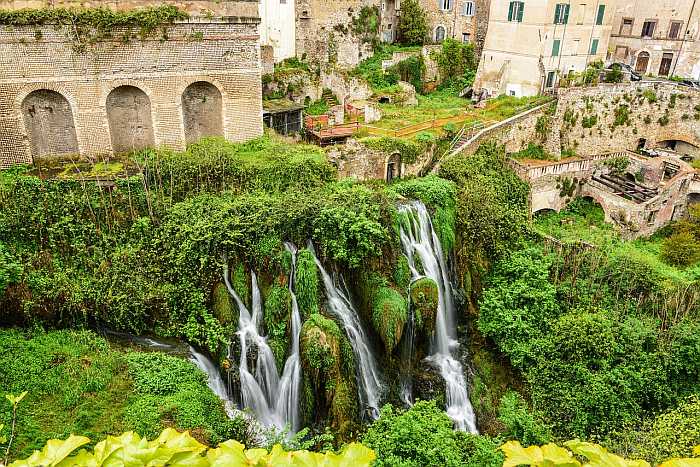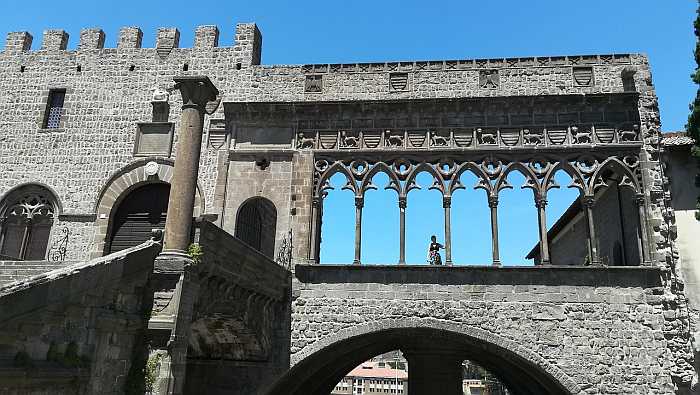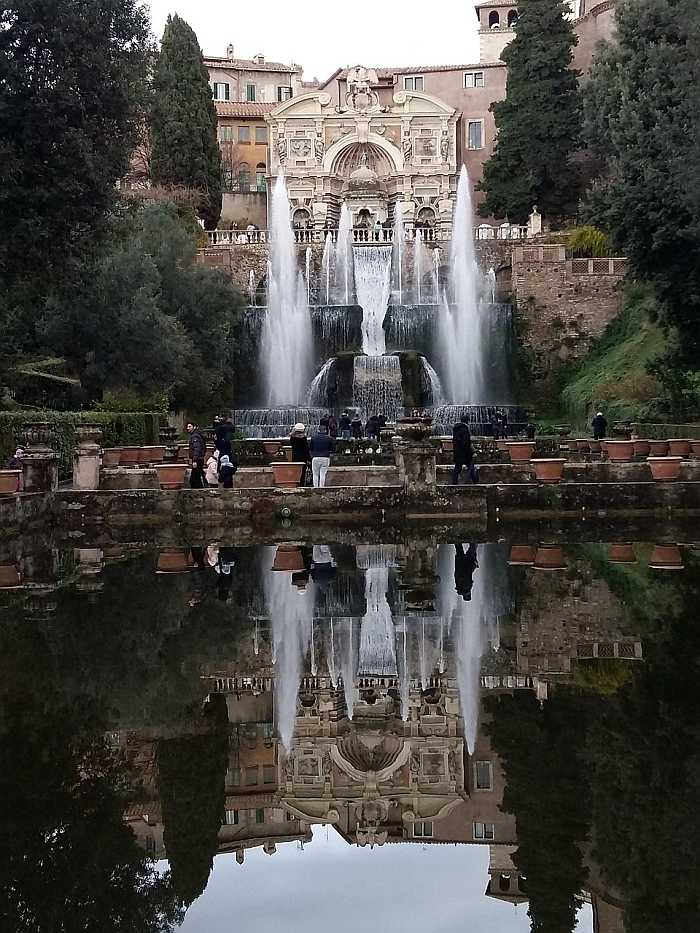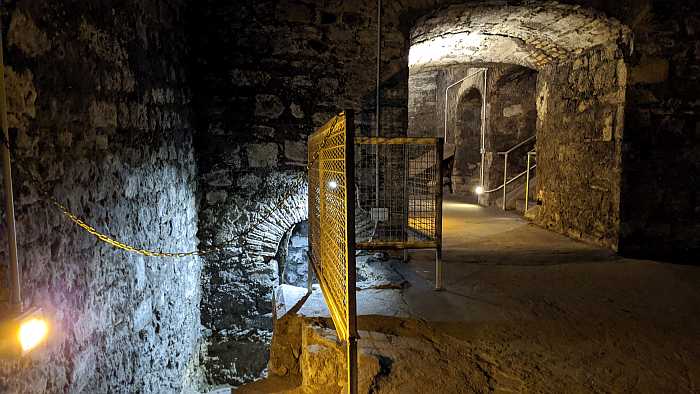
Villa Gregoriana in Tivoli (Photo by Duc Tinh Ngo from Pixabay)
Planning a kosher vacation to Rome? While the Eternal City offers plenty to explore, some of Italy’s most magical (and often overlooked) destinations are just a day trip away. In this series, we’ll spotlight unique towns and ancient sites that offer history, beauty, and a deeper connection to the landscape — all reachable within a day and perfect for curious travelers who want to venture beyond the usual itinerary.
Note for Kosher Travelers: These destinations do not have kosher dining options, so be sure to bring food and snacks from Rome. Many visitors prepare meals in advance or pick up takeout from one of the city’s kosher restaurants or bakeries before heading out.
-wikimedia-commons.jpg)
-wikimedia-commons.jpg)
Palazzo Farnese in Caprarola (Photo: Livioandronico2013, CC BY-SA 4.0, via Wikimedia Commons )
1. Caprarola – A Renaissance Dream in the Heart of Lazio
Travel Time from Rome: About 1.5 hours by car.
Tucked away in the Cimini Mountains north of Rome, Caprarola is a little-known treasure where the grandeur of the Renaissance rises unexpectedly from the quiet countryside. At its heart stands the Palazzo Farnese, one of the most impressive examples of Mannerist architecture in Italy.
Originally conceived as a fortress by Cardinal Alessandro Farnese (the grandson of Pope Paul III), the structure was transformed into a lavish palace by the architect Giacomo Barozzi da Vignola in the 16th century. Its unique pentagonal shape, crowned with an elegant circular courtyard, gives the impression of a fortified jewel box.
Inside, the rooms burst with frescoed wonders — mythological scenes, allegorical figures, celestial maps — painted by the Zuccari brothers and other Renaissance masters. A standout is the Sala del Mappamondo, where a massive globe and stunning maps cover the walls, reflecting the era’s obsession with exploration and power.
The palace opens up onto Italian-style gardens and terraces with panoramic views of Lake Vico and the surrounding woods. There’s even a hidden staircase used by the Farnese family to move discreetly between the floors — a favorite detail for curious visitors.
Fun fact: The Farnese family was so powerful that at one point they considered establishing Caprarola as the capital of a new Farnese-ruled state. Walking through the town, largely untouched by mass tourism, you feel a sense of that faded ambition — as if history paused here, perfectly preserved.


Papal Conclave in Viterbo (Photo by lino9999 from Pixabay)
2. Viterbo – The City of Popes and Medieval Mysteries
Travel Time from Rome: Around 2 hours by car or 2–2.5 hours by regional train.
Viterbo, often called the “City of Popes,” is a medieval gem that exudes timeless charm and stone-carved secrets. Located in northern Lazio, its ancient walls and cobblestone streets have witnessed everything from Etruscan rituals to papal conclaves.
Its centerpiece is the imposing Palazzo dei Papi, where the first-ever papal conclave was held in 1268 — a process that lasted almost three years. Legend has it the frustrated townspeople eventually locked the cardinals in, removed the roof, and rationed their food until they reached a decision! This dramatic episode gave birth to the word conclave ("with a key").
Just outside, the Piazza San Lorenzo and the cathedral offer sweeping views over the rooftops. But perhaps the most atmospheric corner is the San Pellegrino medieval district, the largest in Europe: a labyrinth of arches, towers, and overhanging balconies that hasn’t changed much since the Middle Ages. It’s a living postcard of medieval Italy.
Another treasure lies beneath the surface — literally. Viterbo’s underground tunnels, carved by the Etruscans and expanded over centuries, reveal layers of history used for defense, escape, and even secret trade routes.

Villa Adriana in Tivoli (Photo by elisabeth283 from Pixabay

Villa Adriana in Tivoli (Photo by elisabeth283 from Pixabay
3. Tivoli – Where Emperors and Cardinals Escaped Time
Travel Time from Rome: 45 minutes to 1 hour by car or train.
Just east of Rome lies Tivoli, a town where nature and art intertwine in a timeless symphony. Ancient Romans came here to escape the capital’s chaos, and they left behind astonishing legacies.
The most iconic is Villa Adriana, the sprawling retreat of Emperor Hadrian. Built in the 2nd century AD, it’s not just a villa — it’s a miniature empire, filled with temples, baths, libraries, and theaters. Hadrian, a lover of architecture and travel, modeled sections after places he visited across the empire. Even today, walking through its ruins, you can sense the emperor’s desire to re-create the world in his backyard.
Centuries later, during the Renaissance, Cardinal Ippolito d’Este created Villa d’Este, one of the most extravagant gardens in Europe. Its cascades, water jets, and hidden grottoes — all powered without modern pumps — are an engineering marvel. The Fontana dell’Organo even plays music thanks to water pressure alone!
Then there’s Villa Gregoriana, a romantic 19th-century park built around a dramatic waterfall and a collapsed Roman temple. It feels like a set from a gothic novel: moss-covered ruins, gorges, and tunnels that echo with mystery.
Anecdote: When Goethe visited Tivoli in the 18th century, he was so moved by the landscape that he declared it “a divine spectacle.” Artists and poets followed, making Tivoli a staple of the Grand Tour, immortalized in paintings and verses.
-wikimedia-commons.jpg)
-wikimedia-commons.jpg)
Theater at Ostia Antica (Photo: Rabax63, CC BY-SA 4.0, via Wikimedia Commons)
4. Ostia Antica – A Time Capsule of Roman Daily Life
Travel Time from Rome: About 30–40 minutes by train (Rome’s Porta San Paolo station to Ostia Antica).
Before Pompeii was rediscovered, there was Ostia Antica — and for many, it still offers a more vivid and intimate look at daily life in the Roman Empire.
Located near the coast and just 30 minutes from Rome, Ostia was the empire’s main harbor city, bustling with merchants, sailors, and travelers. Today, its vast ruins lie under open skies, often quiet and uncrowded, allowing for a more contemplative, immersive experience.
You can walk along the Decumanus Maximus, the main street lined with taverns, shops, and bathhouses. Step into the ancient theatre, which still hosts performances today, or admire the intricate mosaics of the Baths of Neptune. The insulae, or apartment buildings, give you a rare glimpse into Roman middle-class life.
Unlike Pompeii, Ostia wasn't destroyed in a cataclysm but gradually abandoned and buried by silt from the Tiber River — which ironically preserved it beautifully. Many of its walls, frescoes, and inscriptions remain remarkably intact.
Here are also the ruins of the oldest Synagogue in the Western hemisphere, dating back from the reign of Emperor Claudius (41-54 AD) and continued in use as a synagogue into the 5th century AD.
Fun fact: One of the earliest examples of a Roman “condominium” can be found here, along with a building known as the "Thermopolium", essentially an ancient Roman fast-food spot, complete with counters and display jars!

Explore the underground tunnels in Viterbo (Mariapia Statile, Photo by CC BY-SA 4.0, via Wikimedia Commons)
Plan Your Day Trip with Confidence
These hidden gems around Rome offer more than just scenic views and fascinating history — they give you the chance to connect with Italy in a deeper, more personal way, all within a day’s reach. While these destinations don’t have kosher food on-site, a little prep goes a long way. Pack a lunch, bring snacks from Rome, and you’ll be ready to explore comfortably.
Stay tuned for more day trip ideas from other iconic Italian cities like Florence and Venice — perfect for kosher travelers who want to go beyond the usual tourist spots.
Andrea Alcalay from La Tour I-Talya. LaTour I-Talya is a project established and managed by a team of Italian Jews working together with one of the largest and most prestigious Italian Tour Operators. LaTour I-Talya specializes in tour packages which focus on the amazingly rich Jewish historical and cultural heritage found throughout Italy — and the many lesser-known gems that exist off the beaten tourist paths.